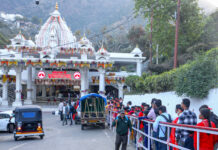 Unique region with no division between river & sea
Unique region with no division between river & sea
Sunderbans, the world’s largest estuarine forest and delta covered by mangrove forests and vast saline mud flats is situated on the lower end of Gangetic West Bengal. A land of 54 tiny islands, criss-crossed by innumerable tributaries of the Ganges that was once infested by Arakanese and Portuguese pirates is now the abode of varied flora and fauna population. Sunderbans is bound on the west by river Muriganga and on the east by rivers Harinbhahga and Raimangal. Other major rivers flowing through this eco-system are Saptamukhi, Thakurain Matla and Gosaba.
Unlike other wildlife parks, where roads, jeeps and guides provide a semblance of control, here visitors will find themselves holding their breath and stiffening to a state of alertness as their boats glide through the creeks and rivulets, bordered with primeval mangrove forest sheltering the most unimaginable dangers in its impenetrable undergrowth. A unique region where there are no borders to divide fresh from saline water, river from sea.
With a little luck one may experience a salt water Crocodile sunbathing in the mud; a flash in the corner of your eye could be deer running into the forests. Most famously, however, this protected area is home to the Royal Bengal Tiger. There are strategically placed watch towers from which, fortunate travelers may get the opportunity to observe the regal beast in its natural surroundings, a thrill that can only be experienced first-hand. Incidentally, these watch towers may be reached only through corridors covered in protective net fencing.
You can explore the wildlife of Sunderbans that harbors jungle cats, fishing cats, axis deer, wild boar, rhesus monkeys, mongooses and the largest estuarine crocodiles in the world. Sunderbans is the breeding ground of immense variety of birds like heron, egret, cormorant, fishing engle, white bellied sea eagle, seagul, tern, kingfisher as well as migratory birds like whimprel, black-tailed godwit, little stint, eastern knot, curlew, sandpiper, golden plover, pintail, white-eyed pochard and also whistling teal. Come and discover wide variety of aquatic and reptile life forms that include Olive Ridley sea turtle, hardshelled Batgur Terrapin, pythons, King Cobra, Chequered Killback, monitor and lizards including the Salvator lizards.
Sunderbans is characterized by the Sundari trees that give the mangrove their name. These trees hold together the small islands of mud, on which they grow, with their roots. Nevertheless, with each incoming tide, the greyish brown silt looses itself to water seamlessly. Sunderbans consists of a large flora population like genwa, dhundal, passur, garjan and kankra. Apart from these trees, impenetrable goran trees between 1.8 meters and 3.6 meters high cover almost the entire region. One of the most remarkable features of this place is the bayonet like roots of mangrove forests that stick out above the water level.
Nature apart, if you want to feel the essence of spirituality then this is the place to be. A place famous for Ma Bonobibi (the goddess of the forest) to Shiber Kumir (Lord Shiva’s crocodile) or from Dakshinaroy (an ogre, the ancestor of all tigers) to Kapil Muni (an incarnation of Vishnu).
UNIQUENESS OF SUNDARBANS FOREST
Sunderbans Biosphere Reserve was constituted by Government of India (GOI) in 1989 and it received the recognition of UNESCO under its Man and Biosphere (MAB) Program in November, 2001. Sunderbans National Park, forming the core area of Sunderbans Tiger Reserve, received recognition as World Heritage Site by UNESCO in 1987. It has been nominated by GOI for recognition as Ramsar Site (a wetland of international importance). Sunderbans Tiger Reserve was constituted by GOI under Project Tiger scheme, in 1973. Sunderbans is the only mangrove forest in the world which is the home of Tigers. Sunderbans Tiger Reserve has the highest tiger population in the world.
Ecosystem
Sunderbans has extremely rich diversity of aquatic and terrestrial flora and fauna. Sunderbans’s highly productive ecosystem acts as a natural fish nursery. Sunderbans mangrove reduces the fury of cyclonic storm and prevents erosion due to tidal action. Finally, millions of people depend on Sunderbans ecosystem for their livelihood and sustenance through fishing, collection of honey and fuelwood/timber.
Topography & Soil
Geologically, the Sunderbans delta is the largest prograding delta on the globe. The region is covered solely by quaternary sediments carried and deposited by the rivers Ganges, Matla & Bidyadhari.
Climate and rainfall
Although the region is situated south of the Tropic of Cancer, the temperature is equable due to its proximity to the sea. Average annual maximum temperature is around 35 C. Average annual rainfall is 1920 mm. Average humidity is about 82% which is more or less uniform throughout the year.
People of the Sunderbans
The people of this area are unique in their occupation and lifestyle, faiths, rituals and beliefs – farmers, fishermen, wood collectors, honey collectors and poachers.
Sunderbans represents a society that is primarily agricultural. The people live in villages adjoining forests which is the home of tigers. For survival, these people have to fight with nature day in and day out. The hardships of daily existence have given rise to fraternal feelings and non-communal traditions. Members of both Hindu and Muslim communities worship the same gods and goddesses.
The two most famous among them are Dakshin Ray and Banabibi. Dakshin Ray is worshiped as the God of Tiger and all those who enter the forests for subsistence, worship Dakshin Ray irrespective of their caste, creed and religion. Banabibi, on the other hand, is considered as the protector of the inhabitants of the forests. She is popular both amongst Hindus and Muslims.
How to Reach
Sunderbans is accessible by air, rail and road via Kolkata. But, as the entire place is a network of river tributaries, you have to take boat ride to visit the remote areas of the park.
Boat is the best bet to explore the park extensively.
International Airport: Kolkata Airport: nearest airport at Kolkata, at 112 km.
Railways: Canning is nearest railhead (48 km).
Road: Road transportation is available from Kolkata for Namkhana (105-kms), Sonakhali (100-kms), Raidighi (76-kms), Canning (64-kms), and Najat (92-kms), which are all near the Sunderbans and have access to the riverine waterways.






